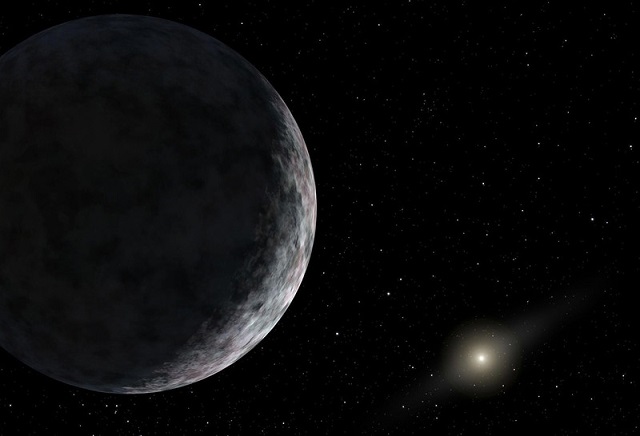
Credit: NASA/JPL-Caltech
Il “Pianeta X” potrebbe effettivamente esistere, anzi, forse non solo uno.” Sono almeno due i pianeti più grandi della Terra che probabilmente si nascondono nelle profondità oscure dello spazio ben oltre Plutone, che aspettano solo di essere scoperti: questo è quello che suggerisce una nuova analisi delle orbite estreme di “oggetti trans-nettuniani” (ETNOS). I ricercatori hanno studiato 13 Etnos, corpi glaciali, come il pianeta nano Sedna che viaggia intorno al sole a grandi distanze in percorsi ellittici.
La teoria prevede un certo insieme di peculiarità per le orbite di tali oggetti, secondo quanto riportano i membri del team di studio. Ad esempio, dovrebbero avere un semiasse maggiore, o la distanza media dal Sole di circa 150 unità astronomiche (UA). (1 UA è è un’unità di misura usata su scala interplanetaria che equivale circa alla distanza media tra la Terra e il Sole. Un’unità astronomica misura 150 milioni di chilometri o approssimativamente 93 milioni di miglia.) Queste orbite dovrebbero avere un’inclinazione, rispetto al piano del sistema solare, di quasi 0 gradi, tra le altre caratteristiche. Ma le orbite attuali dei 13 ETNOS posti in osservazione sono molto diverse, con semiassi maggiori che vanno da 150-525 AU e medie inclinazioni di circa 20 gradi. “Questo eccesso di oggetti con parametri orbitali inaspettati ci fa credere che alcune forze invisibili stiano alterando la distribuzione degli elementi orbitali di questi Etnos, e riteniamo che la spiegazione più probabile è che esistono altri pianeti sconosciuti oltre Nettuno e Plutone”, così riferisce in un comunicato l’autore principale dello studio Carlos de la Fuente Marcos, dell’Università Complutense di Madrid. “Il numero esatto è incerto, dato che i dati che abbiamo è limitato, ma i nostri calcoli suggeriscono che ci sono almeno due pianeti, e probabilmente anche di più, entro i confini del nostro sistema solare”, ha aggiunto.
“Planet X” might actually exist — and so might “Planet Y.” At least two planets larger than Earth likely lurk in the dark depths of space far beyond Pluto, just waiting to be discovered, a new analysis of the orbits of “extreme trans-Neptunian objects” (ETNOs) suggests. Researchers studied 13 ETNOs — frigid bodies such as the dwarf planet Sedna that cruise around the sun at great distances in elliptical paths.
Theory predicts a certain set of details for ETNO orbits, study team members said. For example, they should have a semi-major axis, or average distance from the sun, of about 150 astronomical units (AU). (1 AU is the distance from Earth to the sun — roughly 93 million miles, or 150 million kilometers.) These orbits should also have an inclination, relative to the plane of the solar system, of almost 0 degrees, among other characteristics. But the actual orbits of the 13 ETNOs are quite different, with semi-major axes ranging from 150 to 525 AU and average inclinations of about 20 degrees. “This excess of objects with unexpected orbital parameters makes us believe that some invisible forces are altering the distribution of the orbital elements of the ETNOs, and we consider that the most probable explanation is that other unknown planets exist beyond Neptune and Pluto,” lead author Carlos de la Fuente Marcos, of the Complutense University of Madrid, said in a statement. “The exact number is uncertain, given that the data that we have is limited, but our calculations suggest that there are at least two planets, and probably more, within the confines of our solar system,” he added.
Source/Continue reading → SPACE.com
Leggi anche/Read also:





















